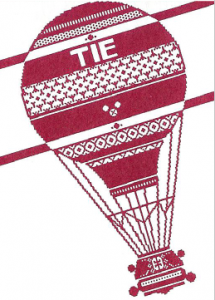 History
History
In the Beginning…computers were being introduced into schools and teachers were hungry for guidance in using them to educate their students. Technology leaders from Colorado traveled to California for the Computer Using Educator (CUE) conference and a group of these educators proceeded to program a “scathingly brilliant” idea (as Pat McCartney so often recalled): Colorado and the surrounding region could support its very own technology conference!
Thus, in October of 1986, a creative and visionary group of educators met to explore the possibilities. Kathy Brabec, Jan Bybee, Randy Donahoo, Rick Dutton, John Emerson, Steve King, Phil Lingwood, Carole Martinez, Kathy Nutting, Bernajean Porter, Jerry Scezney, and John Speckien devoted many hours to planning that first conference and shaping Colorado’s Technology In Education.
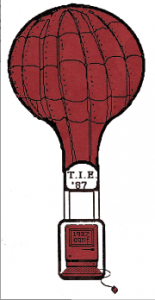
And the story of TIE really is as much a story of people as it is of technology. It would take the entire program to mention all those who have contributed over the years, but a few must be mentioned. Lee Hayward ran the shareware booth for many years, helped us develop Appleworks as a tool for more than we could imagine, and taught us how to troubleshoot pesky technology problems. Those who attended TIE during the 1980s and 90s will always associate the T-shirt distribution with Jeff Koneck of Omaha. We remember his extraordinary zany costumes for the parties, as well as his generous humor and warm smile.
There are many who have continued to provide quality presentations: Len Scrogan, Steve Cowdrey, Spence Cutting, Mary McAuliffe, John DeTroye of Apple, Susan and Bruce Wenzlau, Anne Scott of IBM, Tracy and Richard Sutherland, Gary Murphy, Dave Robnett, Christine Archer-Davison, Denise Shorey, and Martha Wilcox are just some of the presenters who have informed us year after year. We would be remiss not to mention the continuing support of Forest Barbieri from his days with Educational Resources to the Forest Technologies company to Quickmind. He has been a loyal friend of TIE. The contribution of those at ISC (and their previous incarnation as GMT) has been enormous. Without their able assistance, the dream of networking an entire conference while retaining the signature of hands-on presentations as we grew would never have been possible. Hats off to all.
Finally, to all the previous Board members, our eternal gratitude. If you check over the years, you’ll find they made presentations at the conference before they were elected to the Board…and continue to bring their enthusiasm and expertise to the conference as presenters after retiring from the Board. Look around at your presenters this year and you’ll see the faces of some who will join the Board of Directors and lead us through the 21st Century. If history is our guide, it will be a glorious ride!
Thanks to Nancy Jentzsch, who served as historian for this project with the help of Ruby Severson, Kathy Brabec, and Lee Hayward.

Last year’s TIE Conference, New Frontiers, brought TIE participants to accommodating Copper Mountain Resort in late June. Randy Stall served as the conference Chair and the opening festivities featured Roger Pryor from Australia as the keynote speaker. Other conference speakers were Elizabeth Hubbel and John Kuglin.
The one-day Leadership Academy for state leaders evolved from the TIE/ISTE Leadership Bootcamp in 2010 to be an annual TIE session. The Bootcamp, with keynotes Pam Moran, Superintendent of the Albemarle County Public Schools in Virginia, and Ira Socol from the College of Education at Michigan State University, facilitated discussions specially designed for state leaders.
The TIE conference has a long history of helping educators explore ways to better perform their jobs through the use of current technologies. It has also been a lot of fun.
Year by Year
~~~~~~~~~~~~~~~~~~~~~~~~~~~~~~~~~~~~~~~~~~~~~~~~
TIE 1987 — “Moving Schools Into The Information Age”
The first TIE conference was held in Breckenridge in June of 1987 and it established the model for conferences to come. There were two “PreConference” days where whole- and half-day sessions explored educational topics in depth. These sessions were followed by two “Conference” days where one- and two-hour sessions could whet the appetite for concepts to take back to our classrooms.
Keynote speakers Leroy Finkle of CUE and Sue Talley from Apple inspired teachers to continue the drive to incorporate technology. The Colorado Department of Education and John Pierce, head of the Colorado division of the Apple Education Support Group, provided essential financial and organizational support. Apple also sponsored a great tropical island party for the conference, as well as providing computers both for presenters and hands-on labs.
Nearly 400 attendees—many more than the planning group had anticipated—were offered ideas for electronic bulletin boards, desktop publishing, LOGO for programming, software from MECC, Sunburst, and Broderbund, and the concept of TI-IN for Distance Learning. From the beginning, both college and recertification credit was available for teachers attending the conference. The initial conference, symbolized by the familiar balloon logo that TIE still uses today, was a soaring success. Teachers throughout the area clamored for the conference to continue.
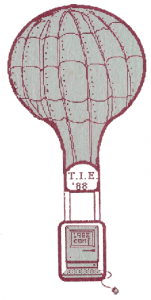 TIE 1988 — “If We Can Dream It, We Can Do It”
TIE 1988 — “If We Can Dream It, We Can Do It”
The following TIE conference was held in Snowmass. The original plan was to return to Breckenridge, but a conflict with the National Educational Computing Conference (NECC) dates and an increase in the number of participants required a roomier facility. There were 70(!) presenters for this second conference. Dick Sloan was a presenter for the first time and has been at every TIE conference since.
Dr. David Thornburg was the keynote speaker. Carole Royster of Apple secured her company’s continuing support by providing computers for hands-on labs—and an Apple party for conference participants. Teachers and administrators got their first look at the Macintosh, HyperCard, the XPRESS Xchange cable modem system, laserdiscs, and video digitizers. A Software Preview Lab was available to those of us who had few opportunities to see a variety of software.
The first TIE Board was elected: John Speckien, Kathy Brabec, Lee Hayward, Bernajean Porter, Sandi Lamberton, and Phil Lingwood. TIE had become an affiliate of ICCE (International Council for Computers in Education) in the spring of 1988. The Board added a TIE bookstore, so attendees could have access to materials that they could browse before purchasing, and borrowed equipment from the Aspen School District, the first of many school districts to support TIE. And, oh, that Primavera Alfredo at Hites!!
The 1989 TIE conference returned to Snowmass where the new technologies that were introduced included Appleshare networking. Hyperstudio, PageMaker, LinkWay, CARL, and IBM computers made their first conference appearance. Jim Mecklenburger of the National School Board and Dr. Ted S. Hasselbring of Vanderbilt University provided the keynote address while Phil Biggs, John Roina, and Ginny Jones joined the TIE Board.
Long-range technology planning was the subject of several presentations; Linda Sharp (then teaching in Cherry Creek, later to be associated with Alphasmart) made the first of many such presentations. The tradition of hands-on labs as a signature feature of the conference was finalized as more than half the rooms were equipped with computers. The first of many Apple Macintoshes was given away at the closing ceremony.
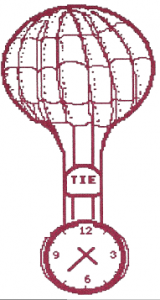 TIE 1990 — “Where In TImE is Technology”
TIE 1990 — “Where In TImE is Technology”
The theme of the 1990 TIE conference, once again in Snowmass, was from the popular Carmen Sandiego software series: it also provided the theme for a party where attendees dressed as characters from the software. No one who was present can forget Kathy Brabec’s Carmen Miranda outfit! Apple again provided equipment and hosted a 50s party introducing Steve Saylor’s Karaoke. We were also introduced to Microsoft Word and Works on the Macintosh, as well as satellite for distance learning.
The proceedings were keynoted by Dudley Lynch and Paul Kordis of Brain Technologies Institute, with a return engagement by Leroy Finkle and Sue Talley, keynote speakers at the initial TIE conference. Beginning this conference, and continuing for seven years, Dan Petro (often partnering with Lynda Welborn) coached attendees on writing technology grants applications. Randy Donahoo, Gary Armour, Donna Dayton, Dianna Lawyer-Brook, and Pat McCartney joined the TIE Board. Pat began a 9-year term serving on the Board, in addition to chairing the conference on three separate occasions.
TIE, now incorporated as a non-profit entity, sought the inspiring scenery of Snowmass again in 1991. The keynote speakers were Al Rogers of the FrEdMail Foundation and George Lugenbill of Apple. Among the technologies highlighted were FrEDmail, classroom publishing, local-area networks (LANs) and CD-ROMs. Scott Weide also joined the Apple team, which provided computers and sponsored the party. Bonnie Fischer, who continues to delight teachers with ideas for the elementary classroom, was a presenter for the first time and John Canuel, Bob VanDerWege, Candy Colborn, Elizabeth Sparkman, and Jack Knutson joined the TIE Board.
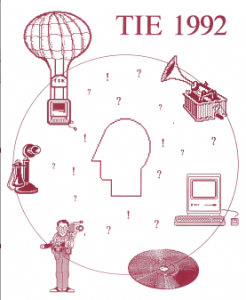 TIE 1992 — “Tools For Excellence”
TIE 1992 — “Tools For Excellence”
The 1992 TIE conference in Snowmass once again engaged Dr. David Thornburg as the keynote speaker. Roger Wagner, a name well-known to those who love Hyperstudio, was a presenter. Apple introduced Quicktime, which wowed everyone who saw it…that Chevrolet actually looked real moving across the screen
Doris Carey and Jeanne Gieck joined the TIE Board, while the latter allied with Kathy Brabec to plan the great TIE parties and provide hospitality to the presenters. The two have been individually, and collectively, responsible for the decorations and gifts at many TIE conferences.
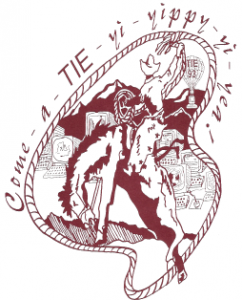 TIE 1993 — “New Frontiers in Education”
TIE 1993 — “New Frontiers in Education”
After finally figuring out where Mt. Chalet and the Crestwood were located at Snowmass, TIE was ready for a new challenge so the 1993 conference became the first held in Steamboat Springs. The frontier theme was seen everywhere, the Sheraton a sea of cowboy hats and hay bales.
Dr. Eliot Soloway of the University of Michigan and Alan November were the keynote speakers. Several sessions were presented on Apple’s Classroom of Tomorrow (ACOT); Kid Pix was the hot new software, and continues to be a staple in elementary classrooms. Grade Busters, a consensus quantum leap over the MECC program, was introduced to help teachers manage their gradebooks on computers. Mike Herr led teachers on the first multimedia field trip, a high point at every conference since, and Nancy Bressler and Tom Spiers joined the TIE Board.
 TIE 1994 — “Rising to the Challenge”
TIE 1994 — “Rising to the Challenge”
The 1994 conference, again in Steamboat Springs, focused on the hottest new technology, the Internet (or “Inter-Net,” as it was often called in the conference program). Teachers were learning how to use email, Gopher, ftp, and Archie, which was all text-based and required knowing what to type on a command line. The internet definitely presented a challenge, but a whole world of information was suddenly available to educators. A graphical way of accessing the “Net” was just emerging.
Pat Wright of TCI and Dr. David Dockterman were the keynote speakers. Mike Wesley and Kay Weider joined the TIE Board.
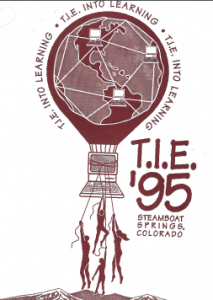 TIE 1995 — “T.I.E. Into Learning”
TIE 1995 — “T.I.E. Into Learning”
The 1995 Steamboat conference brought Apple guru, Guy Kawasaki, as the keynote speaker who managed to bad-mouth IBMs to the extent that even the Apple aficionados were uncomfortable. The Apple party was the occasion for some amazingly bad ties! This was the year of the World Wide Web, however, and were we blown away by what we were seeing for our classrooms.
Rick Spitzer presented his “Giant Graphics” for the first time. This session has been repeated at various TIE conferences since and is always well-received. This was also the year that the new Colorado Technology Plan was unveiled and it became the subject of much discussion among the participants. The Alphasmart was making its appearance at the conference and in classrooms around the area. Mike Herr (who continues to serve) first joined the TIE Board, as did Randy Weigum, Steve Kapchinske, and Brad Michels.
 TIE 1996 — “T.I.E.–Teachers Improving Education”
TIE 1996 — “T.I.E.–Teachers Improving Education”
The 1996 conference in Steamboat celebrated the 10-year anniversary of TIE. In an effort to change things up a bit, the Board decided to have several “Spotlight Speakers” rather than just one or two keynote speakers. Jacqui Celsi of Apple Classrooms of Tomorrow (ACOT), Rick Steenblik of Chromatek, Roger Wagner of HyperStudio fame, and (for a record third time) Dr. David Thornburg all spoke at three separate sessions.
The new technologies explored were the creation of classroom web pages, the use of Powerpoint to create presentations of our lessons, as well as for students to demonstrate their learning, and electronic portfolios as an alternative/supplement to the traditional grading system.
Ruby Severson, TIE’s very own bundle of energy, joined the Board. We took the gondola to the top (in the snow, thank you) and whooped it up at the last party Apple sponsored. Randy Weigum took a unique path back down the mountain—it’s amazing what duct tape on the seat of the pants can accomplish!
 TIE 1997 — “2001, a TIE Odyssey”
TIE 1997 — “2001, a TIE Odyssey”
After a four-year hiatus in Steamboat Springs, the 1997 conference returned to Snowmass. Thanks to the fantastic work of Randy Weigum and the equipment crew, the first conference-wide network provided access to the Internet, In addition, intranets in many labs made the loading of software via Apple Network Administrator Toolkit (ANAT) much easier than had been possible previously.
The Spotlight Speakers this year were Don Crabb of the Chicago Tribune, Dr. Therese Crabb of Jostens Learning, Dan Kinnaman of the Technology & Learning Professional Development Institute, and Joe Lambert of the San Francisco Digital Media Center. Joe lead a workshop in digital storytelling that opened a new door for conference attendees. Teams of parents, students, and teachers worked for three days to produce their stories, then presented them on the last day of the conference.
Besides digital storytelling, Windows 95 was a hot new technology, and Netscape was the new web browser everyone was using. Rubrics were being developed as an evaluation tool, and Accelerated Reading was being touted as a practical application of technology to the assessment of reading comprehension.
Rick Spitzer and Mel Richardson joined the TIE Board and instead of a sit-down dinner or buffet, the conference introduced the “Taste of Snowmass,” a unique dining experience that solved the dilemma of outgrowing the ability of any facility to feed all the attendees in a room or two.
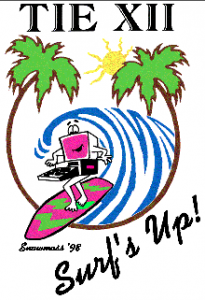 TIE 1998 — “Surf’s Up”
TIE 1998 — “Surf’s Up”
The 1998 conference brought a taste of the beach to the mountains of Colorado surrounding Snowmass. The new technology on display was the DVD while presenters and exhibitors discussed the pros and cons of filtering. Nearly every session room was now a full computer lab, the conference-wide network made possible by 15 school districts who provided equipment.
Linda Sharp, who had been a presenter at TIE since 1989, joined Alphasmart and brought the newest iteration of the keyboard to the conference. She continues to be one of the all-time greatest supporters of TIE, many of us still using the beautiful leatherette cases that were the bags for our conference “stuff.”
Joe Lambert returned to repeat his Digital Storytelling workshop by popular demand. He, along with Annette Lamb of the University of Southern Indiana, Chris Dede of George Mason University, and Phil Raley, advocate extraordinaire of Opelika, Alabama, comprised the conference’s Spotlight Speakers. Jack Kriss and Ike Nelson joined the TIE Board.
 TIE 1999 — “Tech Trek: Mobilizing Standards”
TIE 1999 — “Tech Trek: Mobilizing Standards”
The 1999 conference in Snowmass was the first conference tying all sessions to state and national technology standards. The hot product was Final Cut Pro and the newest technology concept introduced to attendees was the Colorado Online School Consortium, which was beginning to permit students to take classes over the Internet.
Phil Raley was invited back as the conference returned to the concept of a keynote speaker. The Cybercafe was established in the lobby of the Silvertree Hotel and with sixteen computers available throughout the day for Internet browsing and email, conference attendees could stay in touch as never before.
This was the year that Mike’s Camera relieved the Board of the struggle of finding multimedia projectors by outfitting every session room with a presentation device, then sold them to interested districts at a discount at conference end. They have generously continued to provide projectors for every conference since.
The TIE Party brought the Psychedelic Sixties to the Mall, complete with the Board in tie-dyed T-shirts. The AfterParty Party was established to allow participants to continue past the Snowmass Village’s noise ordinance deadline of 10:00 pm. Dave and Dave kept the Cabaret hopping until the wee small hours.
 TIE 2000 — “Stampede to Snowmass”
TIE 2000 — “Stampede to Snowmass”
The 2000 TIE conference, once again in Snowmass, found us wearing cowboy hats. The party featured attendees learning (or perfecting) their line dance skills where boot scootin’ reached a new level! Many of the conference sessions centered on the effective use of multimedia.
Marsha Celesta joined the TIE Board and for the fourth time Dr. David Thornburg was the keynote speaker.
 TIE 2001 — “Expanding Expectations”
TIE 2001 — “Expanding Expectations”
The 2001 conference returned to Snowmass and was keynoted by Dr. Jane Healy, author of numerous award-winning books on the developing brain and the effects of informational technology. The hottest new technolog9cap devices were Global Information Systems (GIS) and Global Positioning Systems (GPS) while the popular new software was iMovie, which made producing a movie on CD a reality for those of us who aren’t video producers. Sessions were also conducted on producing and using Webquests, and how to adapt Six Traits Writing with technology.
The Center for Teaching, Learning, and Technology opened in Denver to serve the entire state. Julie O’Brien presented at several sessions that allowed teachers and administrators to tap into this valuable resource. Randy Stall and Kay Weider joined the TIE Board. Kay, on the Board for the second time, immediately instituted Nature Walks as part of the conference’s offerings.
 TIE 2002 — “Teaming with Technology”
TIE 2002 — “Teaming with Technology”
This TIE conference was the first to be held at Copper Mountain Resort. We approached a conference spread between two distinct areas with some trepidation, even though the planners at Copper had promised we would find adequate transportation between the sites. And the ski busses that constantly circled from Copper Station to the Conference Center made it work!
The keynote speaker for 2002 was John R. Kuglin, a leading advocate and practitioner of technology in the classroom. The hottest technology showcased at the conference was the use of handheld devices by both teachers and students. The live TIE website was the center of attention as several hundred items donated by exhibitors were won by lucky attendees.
 TIE 2003 — “Reach for the Stars”
TIE 2003 — “Reach for the Stars”
The 2003 TIE conference at Copper Mountain featured the first Student Expo for Digital Media. With 205 presentations by 167 presenters over four days, and a budget of a quarter of a million dollars, the conference showcased the maturing of technology in education. While we constantly look for the current “hot” technologies, it is the maturing of the technology and software over the years and the techniques for integrating these vital tools into the curriculum that was evident at the conference.
The keynote speaker was Alan November, who returned to the conference after ten years to update participants on his influential thinking regarding educational technology.
Joe Buzzitta joined the TIE Board and, despite his “retirement,” Steve Saylor couldn’t forego Karaoke at TIE, returning for the 13th year. Chuckie and the Cyclones once again played at the AfterParty Party while the Cybercafe became firmly entrenched as an integral part of TIE. The bookstore continued to provide a valuable service, selling out of most available titles in addition to offering conference materials from previous conferences.
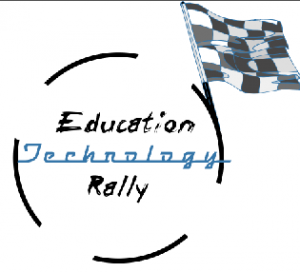 TIE 2004 — “The Education Technology Rally”
TIE 2004 — “The Education Technology Rally”
The theme for the 2004 TIE Colorado conference was as flashy as the red hot convertible featured on the program cover.
 TIE 2005 — “Trailblazing Through Technology”
TIE 2005 — “Trailblazing Through Technology”
 TIE 2006 — “TIE celebrates 20 Years of Technology In Education Colorado!”
TIE 2006 — “TIE celebrates 20 Years of Technology In Education Colorado!”
TIE 2007 — “T.I.E.volution”
The educational revolution in 2007 was lead by conference keynote Will Richardson, a primary resource for the creation and implementation of Weblog technologies at the K-12 level. He is also a leading voice for school reform with regard to the fundamental changes these new technologies bring to all aspects of life. Web 2.0 was gaining momentum as an instructional tool and Richardson took us there with his inspiring keynote and highly practical follow-up sessions.
The conference launched its first wiki containing the latest news, information, and notices concerning the event. Karen Ortiz joined the TIE board after 8 years as a member of the Tech Crew and a little beagle/Jack Russell named Sadie would get protective when anyone would get near her mistress’ golf cart, her home away from home.
RoundTable conversations on hot topics were introduced, along with WebQuests, digital storytelling, McREL’s Using Technology with Classroom Instruction That Works, and Open Source platforms. The conference program presented a timeline of technology history while a provocative YouTube video entitled “The Machine is Us/ing Us” summarized years of communication history, producing just one of many digital buzzes in the air. It left one wondering what the future will bring: Was your guess on target?
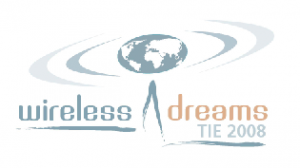 TIE 2008 — “Wireless Dreams”
TIE 2008 — “Wireless Dreams”
Fantasy became a reality in 2008 when TIE made the bold step to host a wireless conference. Dr. Jason Ohler, writer, teacher, researcher, and lifelong digital humanist, was the keynote speaker for the noteworthy event. His presentation and follow-up session, “Digital Storytelling in the Classroom,” discussed digital literacies as well as digital media forms. Jason’s message—literacy in the digital age requires the ability to tell effective stories—provided attendees a four-step instructional process for accomplishing that objective.
Featured Speakers included: Debra Berlin, Howie DiBlasi, Chris O’Neal, and Frank Rizzo. The TIE Board was forced to combine some of the smaller rooms at Mountain Plaza and Copper Station in order to accommodate larger sessions and alleviate the problem of enthusiastic attendees who had to sit on the floor during more popular sessions. Patrick Mount and Bill Grindell were rookie board members.
 TIE 2009
TIE 2009
![]() TIE 2010 — “TIE/ISTE”
TIE 2010 — “TIE/ISTE”
Denver proudly hosted the International Society for Technology in Education (ISTE) Conference! As Regional Program Chair, Karen Ortiz represented the TIE Board in working closely with ISTE’s Program Leadership by leading the Regional Program Team. Colorado’s best and brightest educational technology gurus were selected to present topics demonstrating their expertise to the worldwide audience assembled.
TIE suspended their statewide conference and instead partnered with ISTE to produce a Leadership Bootcamp, the foundation for TIE’s own Leadership Academy. Michelle Bourgoise and Alison Saylor co-chaired the joint event designed to build understanding, facilitate focused conversations, and develop a framework for change around communication and collaboration practices. Four online pre-bootcamp events were hosted by the committee while Jeff Piontek, keynote, and Chris Lehman, featured speaker, as well as many national speakers, gave provocative presentations followed by focused discussions led by Colorado ed tech leaders.
Kim McMonagle was the ISTE Student Showcase chair and Alison Saylor was appointed to the Board as a result of her fine efforts. Erin Magley, party planner extraordinaire, organized a gathering for Colorado attendees on the 27th floor of the Grand Hyatt hotel in addition to a regional affair at the Lucky Strike bowling alley for conference participants from Arizona, New Mexico, Utah, and Wyoming. In all, over 2,000 Colorado educators attended the conference, taking advantage of the reduced registration rate TIE had secured. Several attendees stopped by the TIE booth and commented to the TIE Board members that while they enjoyed ISTE, they couldn’t wait until TIE returned to Copper Mountain Resort in 2011.
